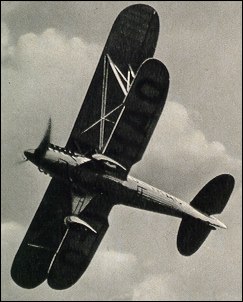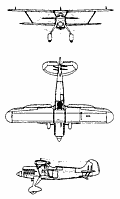 |
Heinkel He 511932 |  |
| FIGHTER | Virtual Aircraft Museum / Germany / Heinkel |
 |
Ernst Heinkel, chief designer of Hansa Brandenburg for a number of years, was responsible for the creation of several significant seaplanes which were built by that company during World War I. Following liquidation of Hansa Brandenburg, Heinkel built a series of seaplanes in Sweden, ostensibly for Svenska. In fact this was a ruse to circumvent the ban on all construction of military aircraft in Germany which had been imposed under the terms of the Versailles Treaty. Following establishment of the new military regime in Germany, Heinkel began the design and construction of aircraft in a factory located at Rostock. There (in 1932) he completed the prototype of a biplane fighter which had the company designation He 49A. A generally similar aircraft with floats, instead of wheel landing gear, was identified as the He 49B. The He 49A design was submitted to the German Air Ministry, which ordered ten pre-production aircraft under the designation He 51, and it was this which became the first single-seat fighter to serve with the new, and then still secret, Luftwaffe. The He 51 was of composite construction and unequal-span single-bay biplane configuration. The single seat for the pilot was in a cockpit just aft of the wings, and a cut-out in the centre-section of the upper wing was made to enhance the pilot's field of view. Power plant comprised a BMW 12-cylinder in-line engine, and adoption of a minimum cowled section provided a bluff, square look to the fuselage nose. Wheel landing gear of the He 51A was neat and functional, that of the He 51B remarkably clean for a float installation. Delivery of the first of the He 51A-0 pre-production aircraft began in late 1933, and the type was among those which were sent to take part in the Spanish Civil War in support of the Nationalists. The first batch of aircraft sent to Spain comprised six He 51A and 20 Junkers Ju 52/3m: these were virtually the foundation aircraft of the Condor Legion. Combat in Spain soon showed that the He 51 was an inferior fighter, but they proved valuable in a close-support role. Because of this they were still in service at the beginning of World War II, being used for a variety of non-combatant duties until 1943. Production versions for the Luftwaffe were the He 51A and He 51C; floatplanes which served with the German Navy had the designation He 51B. Armament: two forward-firing 7.9 mm MG 17 machine-guns Heinkel He 55 (Germany) The He 55 appeared in 1929 and was a two-seat shipboard flying-boat with foldable equal-span single-bay wings and strengthened for catapulting. Power was provided by a 447kW Siemens radial engine mounted in a streamlined nacelle and supported on struts above the front cockpit and well forward of the wings. More than 40 were delivered to Russia, where they were given the designation KR-1. Maximum level speed was 194km/h.

|  COMPANY PROFILE | ||||||||||||||||||||||||||||||||||||||||||||||||||||||||||||
 |

|

